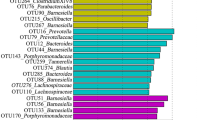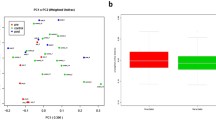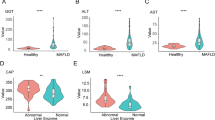Abstract
Bifidobacterium pseudocatenulatum LI09 could prevent D-galactosamine-induced liver injury. Our previous study has preliminarily determined that different intestinal microbiota profiles existed in the LI09-treated rats. Due to the sample size limitation, some subsequent analyses could not be achieved. In the current study, we conducted different experiments and bioinformatic analyses to characterise the distinct intestinal bacterial microbiota profiles in the LI09-treated rats with liver injury (i.e., LI09 group). Partition around medoids clustering analysis determined two intestinal microbiota profiles (i.e., Cluster_1_LI09 and Cluster_2_LI09) in LI09 group. Compared with Cluster_2_LI09, Cluster_1_LI09 group was determined at less dysbiotic microbial status and with lower level of liver injury. The two microbiota profiles were determined with distinct representative amplicon sequence variants (ASVs), among which, ASV1_Akkermansia and ASV3_Bacteroides were most associated with Cluster_1_LI09 and Cluster_2_LI09, respectively. Multiple representative phylotypes in Cluster_1_LI09 negatively correlating with liver function variables were assigned to Parabacteroides, suggesting Parabacteroides could benefit LI09 on modulating the liver function. In addition, ASV310_Lachnospiraceae, ASV501_Muribaculaceae and ASV484_Lachnospiraceae were determined as network gatekeepers in Cluster_1_LI09 network. The relevant results suggest that some intestinal bacteria could assist LI09 in lowering the intestinal microbial dysbiosis in the rats with liver injury, and their clinical application deserves further investigation.






Similar content being viewed by others
Data Availability
Sequencing data have been deposited in the NCBI SRA database under the accession number PRJNA755955.
References
Araújo MPd, Burger E, Dias Novaes R, Ami Akatuti A, Rodrigues M, Mendes ACSC, Bani GMdC, Cardoso Santos E, Santos Mendonca AA, Martins Souza RL (2019) Impact of paracoccidioides brasiliensis coinfection on the evolution of schistosoma mansoni-induced granulomatous liver injury in mice. Biomed Res Int 2019:8319465. https://doi.org/10.1155/2019/8319465
Azarang A, Farshad O, Ommati MM, Jamshidzadeh A, Heidari R, Abootalebi SN, Gholami A (2020) Protective role of probiotic supplements in hepatic steatosis: a rat model study. Biomed Res Int 2020:5487659. https://doi.org/10.1155/2020/5487659
Bajaj JS, Heuman DM, Hylemon PB, Sanyal AJ, White MB, Monteith P, Noble NA, Unser AB, Daita K, Fisher AR (2014) Altered profile of human gut microbiome is associated with cirrhosis and its complications. J Hepatol 60(5):940–947. https://doi.org/10.1016/j.jhep.2013.12.019
Bolyen E, Rideout JR, Dillon MR, Bokulich NA, Abnet CC, Al-Ghalith GA, Alexander H, Alm EJ, Arumugam M, Asnicar F (2019) Reproducible, interactive, scalable and extensible microbiome data science using QIIME 2. Nat Biotechnol 37(8):852–857. https://doi.org/10.1038/s41587-019-0209-9
Callahan BJ, McMurdie PJ, Rosen MJ, Han AW, Johnson AJA, Holmes SP (2016) DADA2: high-resolution sample inference from Illumina amplicon data. Nat Methods 13(7):581–583. https://doi.org/10.1038/nmeth.3869
Chen T, Gao J, Xiang P, Chen Y, Ji J, Xie P, Wu H, Xiao W, Wei Y, Wang S (2015) Protective effect of platycodin D on liver injury in alloxan-induced diabetic mice via regulation of Treg/Th17 balance. Int Immunopharmacol 26(2):338–348. https://doi.org/10.1016/j.intimp.2015.04.001
Chen T, Li R, Chen P (2021) Gut microbiota and Chemical-Induced Acute Liver Injury. Front Physiol 12:753. https://doi.org/10.3389/fphys.2021.688780
Chen Y, Guo J, Qian G, Fang D, Shi D, Guo L, Li L (2015) Gut dysbiosis in acute-on‐chronic liver failure and its predictive value for mortality. J Gastroenterol Hepatol 30(9):1429–1437. https://doi.org/10.1111/jgh.12932
Chen Z-R, Jin S-F, Ma W-B, Jiang R-L (2021) Intestinal microecology: a crucial strategy for targeted therapy of liver diseases. Hepatobiliary Pancreat Dis Int 20(5):499–500. https://doi.org/10.1016/j.hbpd.2021.07.007
DiGiulio DB, Callahan BJ, McMurdie PJ, Costello EK, Lyell DJ, Robaczewska A, Sun CL, Goltsman DS, Wong RJ, Shaw G (2015) Temporal and spatial variation of the human microbiota during pregnancy. Proc Natl Acad Sci USA 112(35):11060–11065. https://doi.org/10.1073/pnas.1502875112
Dong X, Feng X, Liu J, Xu Y, Pan Q, Ling Z, Yu J, Yang J, Li L, Cao H (2019) Characteristics of intestinal microecology during mesenchymal stem cell-based therapy for mouse acute liver injury. Stem Cells International 2019:2403793. https://doi.org/10.1155/2019/2403793
Fang D, Shi D, Lv L, Gu S, Wu W, Chen Y, Guo J, Li A, Hu X, Guo F (2017) Bifidobacterium pseudocatenulatum LI09 and Bifidobacterium catenulatum LI10 attenuate D-galactosamine-induced liver injury by modifying the gut microbiota. Sci Rep 7(1):1–13. https://doi.org/10.1038/s41598-017-09395-8
He C, Wang H, Liao W-D, Peng C, Shu X, Zhu X, Zhu Z-H (2019) Characteristics of mucosa-associated gut microbiota during treatment in Crohn’s disease. World J Gastroenterol 25(18):2204. https://doi.org/10.3748/wjg.v25.i18.2204
Ishak K (1995) Histological grading and staging of chronic hepatitis. J Hepatol 22:696–699. https://doi.org/10.1016/0168-8278(95)80226-6
Kakisaka K, Suzuki Y, Jinnouchi Y, Kanazawa J, Sasaki T, Yonezawa T, Yoshida Y, Kuroda H, Takikawa Y (2019) Unfavorable prognosis of patients with acute liver injury due to drug-induced liver injury and acute exacerbation of hepatitis B virus infection. Hepatol Res 49(11):1286–1293. https://doi.org/10.1111/hepr.13397
Kanmani P, Kim H (2018) Protective effects of lactic acid bacteria against TLR4 induced inflammatory response in hepatoma HepG2 cells through modulation of toll-like receptor negative regulators of mitogen-activated protein kinase and NF-κB signaling. Front Immunol 9:1537. https://doi.org/10.3389/fimmu.2018.01537
Kim HS, Whon TW, Sung H, Jeong Y-S, Jung ES, Shin N-R, Hyun D-W, Kim PS, Lee J-Y, Lee CH (2021) Longitudinal evaluation of fecal microbiota transplantation for ameliorating calf diarrhea and improving growth performance. Nat Commun 12(1):1–16. https://doi.org/10.1038/s41467-020-20389-5
Lee KS, Palatinszky M, Pereira FC, Nguyen J, Fernandez VI, Mueller AJ, Menolascina F, Daims H, Berry D, Wagner M (2019) An automated raman-based platform for the sorting of live cells by functional properties. Nat Microbiol 4(6):1035–1048. https://doi.org/10.1038/s41564-019-0394-9
Lee S-H, Yoon S-H, Jung Y, Kim N, Min U, Chun J, Choi I (2020) Emotional well-being and gut microbiome profiles by enterotype. Sci Rep 10(1):1–9. https://doi.org/10.1038/s41598-020-77673-z
Li L, Duan C, Zhao Y, Zhang X, Yin H, Wang T, Huang C, Liu S, Yang S, Li X (2017) Preventive effects of interleukin-6 in lipopolysaccharide/d-galactosamine induced acute liver injury via regulating inflammatory response in hepatic macrophages. Int Immunopharmacol 51:99–106. https://doi.org/10.1016/j.intimp.2017.08.009
Lu Y, Chen J, Zheng J, Hu G, Wang J, Huang C, Lou L, Wang X, Zeng Y (2016) Mucosal adherent bacterial dysbiosis in patients with colorectal adenomas. Sci Rep 6(1):1–10. https://doi.org/10.1038/srep26337
Ma N, Qi Y, Liang X, Bai J, Deng J, Li M, He Z (2021) Compare the effect of inhaled corticosteroids and systemic corticosteroids on sputum microbiome of AECOPD. Front Med 8:134. https://doi.org/10.3389/fmed.2021.637246
Ndeh D, Gilbert HJ (2018) Biochemistry of complex glycan depolymerisation by the human gut microbiota. FEMS Microbiol Rev 42(2):146–164. https://doi.org/10.1093/femsre/fuy002
Ommati MM, Li H, Jamshidzadeh A, Khoshghadam F, Retana-Márquez S, Lu Y, Farshad O, Nategh Ahmadi MH, Gholami A, Heidari R (2022) The crucial role of oxidative stress in non-alcoholic fatty liver disease-induced male reproductive toxicity: the ameliorative effects of iranian indigenous probiotics. Naunyn-Schmiedeberg’s. Arch Pharmacol 395(2):247–265. https://doi.org/10.1007/s00210-021-02177-0
Ondee T, Pongpirul K, Visitchanakun P, Saisorn W, Kanacharoen S, Wongsaroj L, Kullapanich C, Ngamwongsatit N, Settachaimongkon S, Somboonna N (2021) Lactobacillus acidophilus LA5 improves saturated fat-induced obesity mouse model through the enhanced intestinal Akkermansia muciniphila. Sci Rep 11(1):1–16. https://doi.org/10.1038/s41598-021-85449-2
Shinozawa T, Kimura M, Cai Y, Saiki N, Yoneyama Y, Ouchi R, Koike H, Maezawa M, Zhang R-R, Dunn A (2021) High-fidelity drug-induced liver injury screen using human pluripotent stem cell–derived organoids. Gastroenterology 160(3):831–846. https://doi.org/10.1053/j.gastro.2020.10.002
Shteyer E, Ya’acov AB, Zolotaryova L, Sinai A, Slae M, Cohen S, Ilan Y (2019) Prevention of acetaminophen-induced liver injury by alginate. Toxicol Appl Pharmacol 363:72–78. https://doi.org/10.1016/j.taap.2018.11.008
Stokholm J, Blaser MJ, Thorsen J, Rasmussen MA, Waage J, Vinding RK, Schoos A-MM, Kunøe A, Fink NR, Chawes BL (2018) Maturation of the gut microbiome and risk of asthma in childhood. Nat Commun 9(1):1–10. https://doi.org/10.1038/s41467-017-02573-2
Sun J, Zhao F, Lin B, Feng J, Wu X, Liu Y, Zhao L, Zhu B, Wei Y (2020) Gut microbiota participates in antithyroid drug induced liver injury through the lipopolysaccharide related signaling pathway. Front Pharmacol 11:2094. https://doi.org/10.3389/fphar.2020.598170
Tango CN, Seo S-S, Kwon M, Lee D-O, Chang HK, Kim MK (2020) Taxonomic and functional differences in cervical microbiome associated with cervical cancer development. Sci Rep 10(1):1–10. https://doi.org/10.1038/s41598-020-66607-4
Thiele M, Detlefsen S, Møller LS, Madsen BS, Hansen JF, Fialla AD, Trebicka J, Krag A (2016) Transient and 2-dimensional shear-wave elastography provide comparable assessment of alcoholic liver fibrosis and cirrhosis. Gastroenterology 150(1):123–133. https://doi.org/10.1053/j.gastro.2015.09.040
Vega M, Verma M, Beswick D, Bey S, Hossack J, Merriman N, Shah A, Navarro V (2017) The incidence of drug-and herbal and dietary supplement-induced liver injury: preliminary findings from gastroenterologist-based surveillance in the population of the state of Delaware. Drug Saf 40(9):783–787. https://doi.org/10.1007/s40264-017-0547-9
Wagner Mackenzie B, Waite DW, Hoggard M, Douglas RG, Taylor MW, Biswas K (2017) Bacterial community collapse: a meta-analysis of the sinonasal microbiota in chronic rhinosinusitis. Environ Microbiol 19(1):381–392. https://doi.org/10.1111/1462-2920.13632
Wang G, Pan R, Liang X, Wu X, Wu Y, Zhang H, Zhao J, Chen W (2021) Perfluorooctanoic acid-induced liver injury is potentially associated with gut microbiota dysbiosis. Chemosphere 266:129004. https://doi.org/10.1016/j.chemosphere.2020.129004
Wang K, Liao M, Zhou N, Bao L, Ma K, Zheng Z, Wang Y, Liu C, Wang W, Wang J (2019) Parabacteroides distasonis alleviates obesity and metabolic dysfunctions via production of succinate and secondary bile acids. Cell Rep 26(1):222–235. https://doi.org/10.1016/j.celrep.2018.12.028
Wang Q, Lv L, Jiang H, Wang K, Yan R, Li Y, Ye J, Wu J, Wang Q, Bian X (2019) Lactobacillus helveticus R0052 alleviates liver injury by modulating gut microbiome and metabolome in d-galactosamine-treated rats. Appl Microbiol Biotechnol 103(23):9673–9686. https://doi.org/10.1007/s00253-019-10211-8
Wang Y, Wu Y, Wang B, Xu H, Mei X, Xu X, Zhang X, Ni J, Li W (2019) Bacillus amyloliquefaciens SC06 protects mice against high-fat diet-induced obesity and liver injury via regulating host metabolism and gut microbiota. Front Microbiol 10:1161. https://doi.org/10.3389/fmicb.2019.01161
Wu T-R, Lin C-S, Chang C-J, Lin T-L, Martel J, Ko Y-F, Ojcius DM, Lu C-C, Young JD, Lai H-C (2019) Gut commensal Parabacteroides goldsteinii plays a predominant role in the anti-obesity effects of polysaccharides isolated from Hirsutella sinensis. Gut 68(2):248–262. https://doi.org/10.1136/gutjnl-2017-315458
Yan R, Wang K, Wang Q, Jiang H, Lu Y, Chen X, Zhang H, Su X, Du Y, Chen L (2021) Probiotic Lactobacillus casei Shirota prevents acute liver injury by reshaping the gut microbiota to alleviate excessive inflammation and metabolic disorders. Microb Biotechnol 0(0):1–15. https://doi.org/10.1111/1751-7915.13750
Yang H, Cai R, Kong Z, Chen Y, Cheng C, Qi S, Gu B (2020) Teasaponin ameliorates murine colitis by regulating gut microbiota and suppressing the immune system response. Front Med 7:950. https://doi.org/10.3389/fmed.2020.584369
Yu L, Wang L, Wu X, Yi H (2021) RSPO4-CRISPR alleviates liver injury and restores gut microbiota in a rat model of liver fibrosis. Commun Biol 4(1):1–11. https://doi.org/10.1038/s42003-021-01747-5
Yu L, Zhao X-k, Cheng M-l, Yang G-z, Wang B, Liu H-j, Hu Y-x, Zhu L-l, Zhang S, Xiao Z-w (2017) Saccharomyces boulardii administration changes gut microbiota and attenuates D-galactosamine-induced liver injury. Sci Rep 7(1):1–7. https://doi.org/10.1038/s41598-017-01271-9
Zha H, Chen Y, Wu J, Chang K, Lu Y, Zhang H, Xie J, Wang Q, Tang R, Li L (2020) Characteristics of three microbial colonization states in the duodenum of the cirrhotic patients. Future Microbiol 15(10):855–868. https://doi.org/10.2217/fmb-2019-0270
Zha H, Fang D-Q, van Der Reis A, Chang K, Yang L-Y, Xie J-J, Shi D, Xu Q-M, Li Y-T, Li L-J (2020) Vital members in the gut microbiotas altered by two probiotic Bifidobacterium strains against liver damage in rats. BMC Microbiol 20:1–12. https://doi.org/10.1186/s12866-020-01827-2
Zha H, Lewis G, Waite DW, Wu J, Chang K, Dong Y, Jeffs A (2019) Bacterial communities associated with tail fan necrosis in spiny lobster, Jasus edwardsii. FEMS Microbiol Ecol 95(6):fiz070. https://doi.org/10.1093/femsec/fiz070
Zha H, Li Q, Chang K, Xia J, Li S, Tang R, Li L (2022) Characterising the intestinal bacterial and fungal microbiome associated with different cytokine profiles in two Bifidobacterium strains pre-treated rats with D-galactosamine-induced liver injury. Front Immunol 13:791152. https://doi.org/10.3389/fimmu.2022.791152
Zha H, Liu F, Ling Z, Chang K, Yang J, Li L (2021) Multiple bacteria associated with the more dysbiotic genitourinary microbiomes in patients with type 2 diabetes mellitus. Sci Rep 11(1):1–13. https://doi.org/10.1038/s41598-021-81507-x
Zha H, Lu H, Wu J, Chang K, Wang Q, Zhang H, Li J, Luo Q, Lu Y, Li L (2020) Vital members in the more dysbiotic oropharyngeal microbiotas in H7N9-infected patients. Front Med 7:396. https://doi.org/10.3389/fmed.2020.00396
Zha H, Si G, Wang C, Zhang H, Li L (2022) Multiple intestinal bacteria associated with the better protective effect of Bifidobacterium pseudocatenulatum LI09 against rat liver injury. Biomed Res Int 2022:8647483. https://doi.org/10.1155/2022/8647483
Zhao B-B, Li H-M, Gao X, Ye Z-H, Cheng S-S (2015) The herbal compound “diwu yanggan” modulates liver regeneration by affecting the hepatic stem cell microenvironment in 2-acetylaminofluorene/partial hepatectomy rats. Evid Based Complement Alternat Med 2015:468303. https://doi.org/10.1155/2015/468303
Zheng Z, Wang B (2021) The gut-liver Axis in health and disease: the role of gut microbiota-derived signals in liver injury and regeneration. Front Immunol 12:775526. https://doi.org/10.3389/fimmu.2021.775526
Acknowledgements
Thanks to Jinlin Cheng, Pei Zhang, Hua Zhang for their help in the laboratory.
Funding
This work was supported by the National Natural Science Foundation of China (82003441 and 81790631), the Independent Task of State Key Laboratory for Diagnosis and Treatment of Infectious Diseases (2021ZZ15), the National Key Research and Development Program of China (2018YFC2000500).
Author information
Authors and Affiliations
Contributions
H.Z. conducted the experiments, data analyses and wrote the draft manuscript. J.X., R.T., S.L. and Q.L. conducted the experiments and sorted out the dataset. G.S., Y.L. and W.W. provided critical suggestions and helped with the data analyses. K.C. reviewed the statistical analyses and academic English writing. L.L. supervised the whole work and revised the manuscript.
Corresponding author
Ethics declarations
Conflict of interest
The authors have no conflicts of interest to declare.
Ethics approval
The present study was approved by Animal Care and Use Committee of the First Affiliated Hospital, Zhejiang University School of Medicine.
Additional information
Publisher’s Note
Springer Nature remains neutral with regard to jurisdictional claims in published maps and institutional affiliations.
Electronic supplementary material
Below is the link to the electronic supplementary material.
Rights and permissions
Springer Nature or its licensor (e.g. a society or other partner) holds exclusive rights to this article under a publishing agreement with the author(s) or other rightsholder(s); author self-archiving of the accepted manuscript version of this article is solely governed by the terms of such publishing agreement and applicable law.
About this article
Cite this article
Zha, H., Xia, J., Si, G. et al. Characteristics of the intestinal bacterial microbiota profiles in Bifidobacterium pseudocatenulatum LI09 pre-treated rats with D-galactosamine-induced liver injury. World J Microbiol Biotechnol 39, 43 (2023). https://doi.org/10.1007/s11274-022-03495-y
Received:
Accepted:
Published:
DOI: https://doi.org/10.1007/s11274-022-03495-y




